The Best Tools and Equipment for DIY Floor Sanding
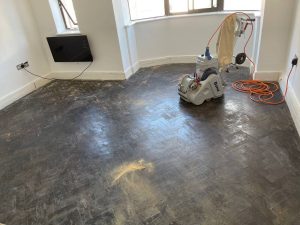
Ensure Professional Results in Your London Home with These Essential Items
Introduction
Embarking on a DIY floor sanding project can be a rewarding way to rejuvenate your wooden floors. To achieve professional-quality results, it’s essential to use the right tools and equipment. In this guide, we’ll outline the best tools and equipment for DIY floor sanding, helping you transform your London home with confidence.
Essential Tools for Floor Sanding
Having the right tools can make a significant difference in the quality of your floor sanding project. Here are the essential tools you’ll need:
- Drum Sander: Ideal for sanding large, flat areas of your floor. A drum sander is powerful and efficient, making it a must-have for removing old finishes and smoothing the wood surface.
- Edging Sander: Used for sanding edges and corners that a drum sander cannot reach. This tool ensures a consistent finish across the entire floor.
- Orbital Sander: A versatile tool that’s perfect for finer sanding tasks and achieving a smooth finish. It’s also useful for sanding in tighter spaces.
- Detail Sander: Great for intricate areas and tight corners where larger sanders cannot reach. This tool helps ensure every part of your floor is evenly sanded.
Sandpaper and Grit Sequences
Choosing the right sandpaper is crucial for a successful sanding project. Here’s a guide to sandpaper grits you’ll need:
- 36-Grit: Coarse sandpaper used for the initial sanding pass to remove old finishes and deep scratches.
- 60-Grit: Medium grit sandpaper to smooth out the rough surface left by the 36-grit paper.
- 80-Grit: Finer grit sandpaper used to further refine the surface.
- 120-Grit: Fine sandpaper for the final pass, ensuring a smooth and even surface ready for finishing.
Additional Equipment
In addition to sanders and sandpaper, you’ll need a few more items to complete your DIY floor sanding project:
- Vacuum Cleaner: A powerful vacuum cleaner with a HEPA filter to remove dust and debris between sanding passes and after the final sanding.
- Protective Gear: Safety goggles, a dust mask, and ear protection are essential for protecting yourself from dust and noise during the sanding process.
- Plastic Sheeting: Use plastic sheeting to seal off doorways and vents to prevent dust from spreading to other areas of your home.
- Wood Filler: Fill any cracks or holes in the floor before sanding to ensure a smooth, even surface.
- Brushes and Rollers: Use these for applying stain and finish to the sanded floor, ensuring an even and professional-looking finish.
Tips for Successful DIY Floor Sanding
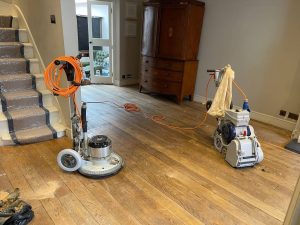
Follow these tips to achieve the best results from your DIY floor sanding project:
- Test Your Equipment: Before starting, test all your equipment to ensure it’s in good working condition.
- Follow Grit Sequences: Don’t skip grits when sanding. Follow the recommended sequence to achieve a smooth finish.
- Keep the Sander Moving: Always keep the sander moving to avoid creating gouges or uneven spots on the floor.
- Vacuum Between Passes: Remove dust and debris between each sanding pass to prevent scratches and ensure a clean surface.
- Work in Good Lighting: Ensure the room is well-lit so you can see the condition of the floor clearly as you sand.


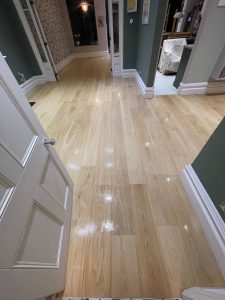
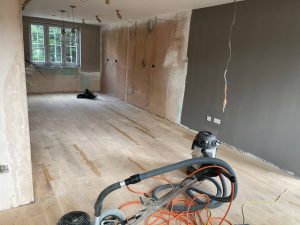
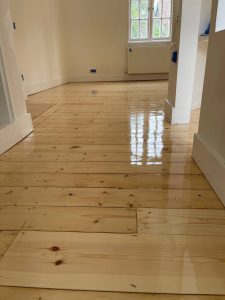

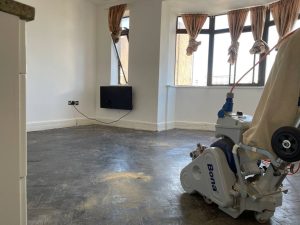
Floor Board Restoration
Restoration Whilst you may believe that floor sanding itself is classed as restoration, floor restoration[Read more...]
Pet-Friendly Floor Sanding Solutions
As a pet owner, maintaining beautiful wooden floors while ensuring the safety and comfort of[Read more...]
Gallery 07 – Pine floor board
[Read more...]
How to Deal with High Traffic Areas on Sanded Floors
How to Deal with High Traffic Areas on Sanded Floors Protect and Maintain[Read more...]
Floor sanding and renovation and installation services in Greenwich
Greenwich: A Historic Gem of London Greenwich is one of London’s most historic and picturesque[Read more...]
Wood floor polishing
[Read more...]
Buffing and one coat finish
[Read more...]
What to Expect During a Floor Sanding Project
What to Expect During a Floor Sanding Project Preparing for a Smooth and Successful[Read more...]
How to Protect Your Furniture During Floor Sanding
How to Protect Your Furniture During Floor Sanding Expert Tips to Keep Your Belongings[Read more...]
Floor Sanding for Stairs: Techniques and Tips
Floor Sanding for Stairs: Techniques and Tips Enhance the beauty and longevity[Read more...]